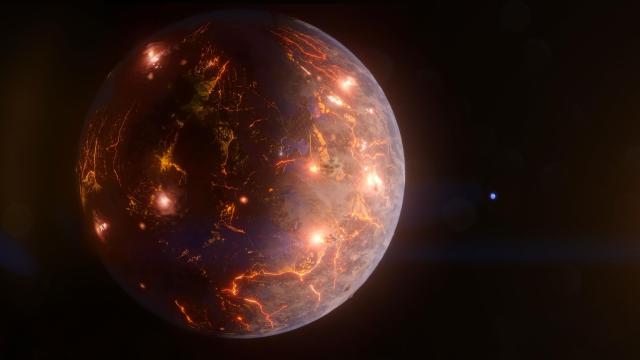On this world, the floor is lava and there’s no couch to jump to: Astronomers have described a planet that might be completely covered in active volcanoes.
Data from NASA’s Transiting Exoplanet Survey Satellite and the now deactivated Spitzer Space Telescope revealed an Earth-size rocky planet with some extreme features. The planet, called LP 791-18 d, is orbiting a red dwarf about 90 light-years away from Earth in the Crater constellation. The world’s elliptical orbit causes it to slightly deform every time it passes close to the dwarf star, creating friction inside the planet that could cause volcanic activity all across its surface. A research paper from the astronomers about the planet is published today in Nature.
“LP 791-18 d is tidally locked, which means the same side constantly faces its star,” said co-author Björn Benneke, an astronomy professor at the Université de Montréal, in a NASA press release. “The day side would probably be too hot for liquid water to exist on the surface. But the amount of volcanic activity we suspect occurs all over the planet could sustain an atmosphere, which may allow water to condense on the night side.”
There are two other planets in the star system, called LP 791-18 b and c. LP 791-18 b is about 20% bigger than Earth, while c is 2.5 times the width of Earth and seven times its mass. Researchers have reserved time to study LP 791-18 c using the Webb Space Telescope. The data on the potentially volcanic LP 791-18 d came from the defunct Spitzer; they were some of the final observations the telescope took. Despite the planet’s harsh surface, the researchers believe that this geologic activity and potential atmosphere could foster a habitable environment.
“A big question in astrobiology, the field that broadly studies the origins of life on Earth and beyond, is if tectonic or volcanic activity is necessary for life,” said co-author Jessie Christiansen, a researcher NASA’s Exoplanet Science Institute. “In addition to potentially providing an atmosphere, these processes could churn up materials that would otherwise sink down and get trapped in the crust, including those we think are important for life, like carbon.”
Astronomers don’t need to look so far away to study extraterrestrial volcanoes. Here in our solar system, Jupiter’s moon Io is positively glowing with volcanic activity. And Venus, whose geologic activity has remained mysterious, may have hosted a volcanic eruption in the early 1990s, a recent data analysis revealed.
